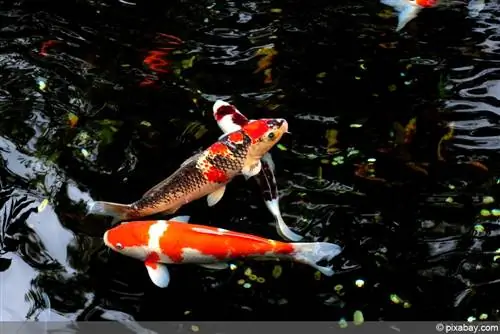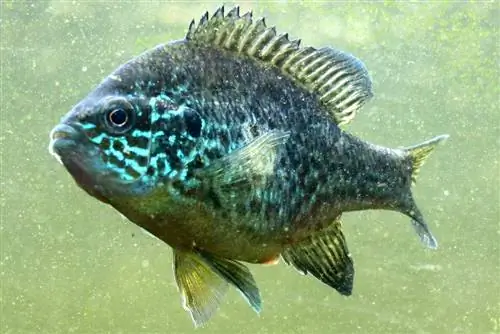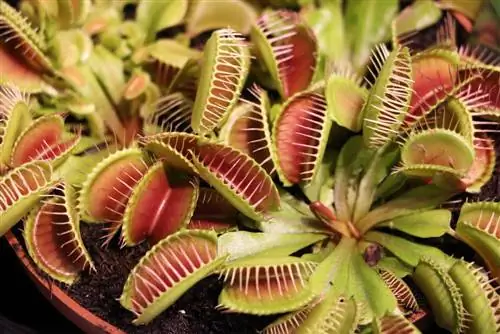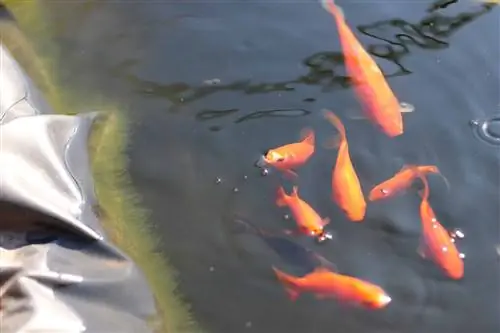- Author admin [email protected].
- Public 2023-12-17 03:39.
- Last modified 2025-06-01 06:48.
A pond, some food and maybe fresh water every now and then - that's all goldfish need, right? Keeping them is actually very simple, but many people still do not take the low demands of cold water fish into account and thus significantly shorten their life expectancy. With the right knowledge, however, the animals can live up to 25 years and also enchant observers.
Location
When creating a garden pond for goldfish, the location or location should first and foremost be considered and chosen very carefully. The garden pond must not be in direct sun, should be as large as possible and about a third should be shaded. At the same time, it is impractical if it stands directly next to large plants whose leaves or needles could contaminate the water.
A good place is therefore close to a wall or in the immediate vicinity of, but not directly under, trees, bushes or hedges and with sufficient distance from plants that shed a lot of leaves or serve as a nesting place for birds. It should also be noted that maintenance measures are occasionally necessary on the pond and a corresponding amount of free space is required at the edge.
Pond
As big as possible, as deep as possible - that is the “rule of thumb”. From a depth of 1.5m the fish can spend the winter in the pond. The amount of water also makes care easier, as a he althy balance and appropriate water values are easier to establish and maintain. If you really want to make it easy to keep goldfish, make your garden pond very deep and large. You should also pay attention to the following factors:
- Introduce natural substrate, such as earth or gravel, for the goldfish to feed on
- Use aquatic plants for different depths, as food, protection and shade
- Create different levels
- Make sure at least a third of the surface is shaded
If the pond is varied with stones, plants and different levels, the goldfish can decide on their current comfort zone and, if necessary, seek protection.
Tip:
Rule of thumb for pond size and stocking is two fish per cubic meter of water.
Water and temperature
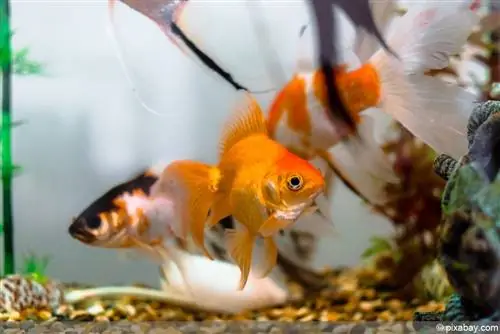
Goldfish, especially breeds for the pond, are very robust and have large tolerance ranges - also with regard to the water. Of course you can simply add tap water to the pond. However, there is a risk that individual or all values will fall outside the tolerance ranges and the fish will be damaged.
It is better to carry out a water analysis with a self-test in advance or to have a water sample carried out at a pet store. The individual values can then be set accordingly. The following are ideal for goldfish:
- Temperatures between 18 and 24°C in summer and 6 and 14°C in winter
- pH value between 7 and 8
- Total hardness 12 to 18°d
- Carbonate hardness 10 to 14°d
- Ammonium less than 0.1 mg/l
- Nitrite less than 0.1 mg/l
- Nitrate less than 25 mg/l
- Carbon dioxide less than 20 mg/l
When it comes to temperatures, there are differences not only between summer and winter, but also between goldfish species. Breeding forms with a veiled tail, lion's head or shortened fins usually require more warmth and require minimum temperatures of 12 or 15°C even in winter. They are therefore only partially suitable for keeping in garden ponds.
Protection
Various protective measures are important when keeping goldfish in a garden pond. On the one hand from other animals, on the other hand from pollution and the complete freezing of the water surface. Cats and herons may see the goldfish as a welcome meal. Although nets provide a solution, they are not exactly visually appealing and also pose a risk to birds as they can get caught in them. Figures of herons are intended to keep such visitors away from the garden pond.
A small, flat bank area and a large body of water help against cats, as well as large-leaved aquatic plants that provide privacy. A filter and - ideally daily - removal of leaves, twigs and stalks help against contamination. A quiver should be used at least once a week to remove fallen foreign bodies.
Feeding
Goldfish rummage on the ground and filter nutrients from the bottom; they feed on aquatic plants and aquatic organisms. If only a few goldfish decorate the garden pond and it is set up appropriately for their species, they do not even need to be fed every day. However, the more animals there are and the more barren the garden pond, the more important supplementary feeding becomes.
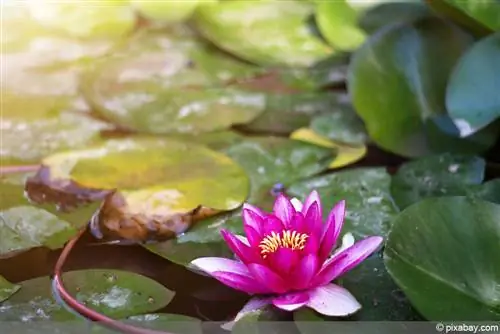
Specialist retailers offer appropriate feed in the form of flakes, granules and pellets that are specifically tailored to goldfish. So supply is easy in this regard. What is also important is how often and how you feed. What matters here is that:
- As small quantities as possible should be fed so that the leftovers do not affect the water quality
- To feed in a targeted manner, for example with a feeding ring
- Feed in stages so that there are no leftovers
- Excess food that has not been eaten after a few minutes should be removed if possible
Tip:
In order to get a feeling for the right amount, only a small amount should be given at the beginning. The measure is repeated until the goldfish leave food left over. If you use a spoon as a guide and count, you can save yourself this effort later.
Filter
Aquatic plants and microorganisms create a self-cleaning effect in the garden pond. However, this is not always enough to decompose fish feces and leftover food, to keep the water quality within the goldfish's tolerance range and to prevent algae. It is therefore safer to integrate a filter into the garden pond. What is important when choosing is the suitability for outdoor use and the design for the water volume of the garden pond. The possibility of switching on UV light, which kills algae during filtering, is recommended. This may sound unnecessarily complicated, but it actually makes the effort easier. The addition of additional additives and the manual removal of algae are reduced by the initial investment in a suitable filter.
Tip:
If the filter is chosen for a larger water capacity than the pond actually has, it does not have to be operated day and night. It is usually enough to only run it at night or only during the day. A timer also makes this effort easier.
Cleaning
Manual cleaning should not be neglected in the garden pond - regardless of whether goldfish should be introduced or not. The important thing is:
- Removing leaves, twigs and other dead plant parts, for example with a quiver
- Removing algae, including from aquatic plants
- Sucking out debris and sludge with a debris vacuum cleaner
Diseases
Typical diseases in goldfish are injuries to the swim bladder and fungal diseases. Swim bladder injury can occur if the goldfish is damaged during transport, swallows air, or is infected with bacteria. The animal is then no longer able to really control the swimming height and direction. This makes, among other things, food intake more difficult.
Recovery is possible but not likely in every case. On the one hand, appropriate medication can be used as help and treatment and, on the other hand, feeding can be adjusted. Flakes are more likely to stay on the surface, granules sink more quickly into the middle areas, food tablets are ideal for fish that are only at the bottom.
For fungal infections, special fungicides from specialist retailers should be used. Such infections are primarily noticeable through the loss of scales and the formation of fungal deposits on the skin.
Tip:
In order to remove the medication from the water after the treatment, filter inserts with activated carbon can be used.
Propagation
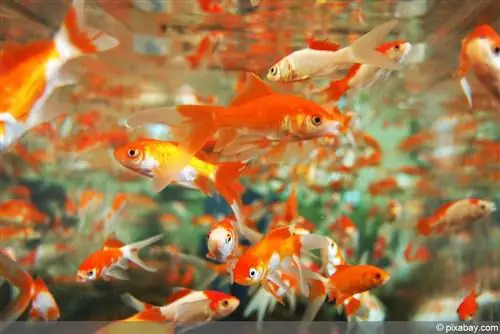
People no longer have to pay taxes for the reproduction of goldfish if the keeping conditions are otherwise optimal. Because these are the best conditions for a small group of goldfish to become a whole swarm. In any case, it is important that the fish have enough space. So you should really take into account when stocking for the first time. No more than two goldfish per cubic meter of water.
In an appropriately equipped garden pond with protection, food and filter, no special effort needs to be made to promote reproduction. If it doesn't work with the offspring, it's worth taking a look at the housing conditions. If these are adjusted as described and there is enough space available, it is only a matter of time before a small swarm can form in the pond.
Tip:
Goldfish are not initially orange or yellowish, but almost black. This means they are visually better protected from enemies in the water but are also more difficult to recognize.
Wintering
As mentioned, goldfish can be left outdoors in winter at a pond depth of 1.5 m. Even deeper is better. It is also important that the water surface does not freeze completely. The decisive factors are:
- Prevent complete freezing with Styrofoam or special plastic balls
- Stop feeding as soon as the temperature drops below 8°C
- Turn off the filter to avoid mixing warm and cold water
- It's better to bring fish into the house below 8°C
If overwintering outdoors is not possible due to the pond depth or temperature, the goldfish must be brought indoors. A bucket, a barrel or an aquarium in a frost-free room must be available. Filters, oxygen or feeding are not necessary. However, as already in the pond, there should be as much water as possible. In addition, the fish should be checked regularly in order to detect diseases at an early stage and to be able to remove dead specimens from the water.

